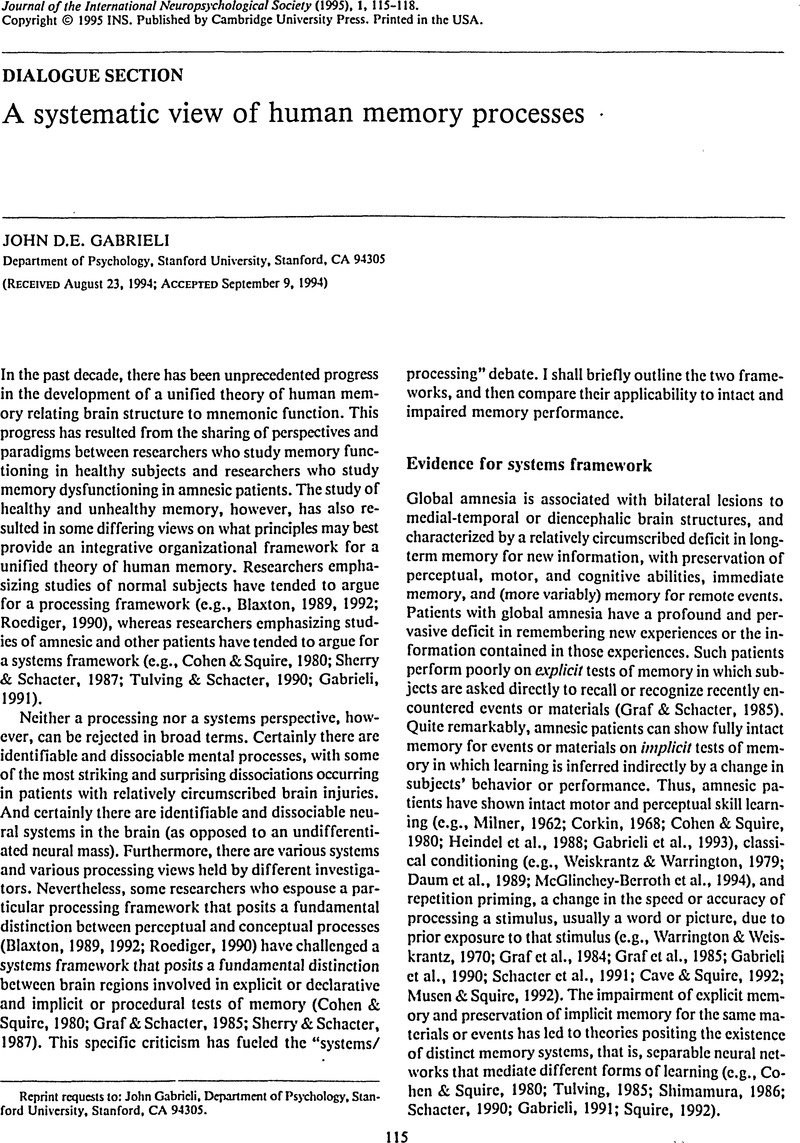Crossref Citations
This article has been cited by the following publications. This list is generated based on data provided by Crossref.
Maki, Pauline M.
1995.
Is implicit memory preserved in alzheimer's disease? implications for theories of implicit memory.
Aging, Neuropsychology, and Cognition,
Vol. 2,
Issue. 3,
p.
192.
Rich, Jill B.
Bylsma, Frederick W.
and
Brandt, Jason
1996.
Item Priming and Skill Learning in Amnesia.
Journal of Clinical and Experimental Neuropsychology,
Vol. 18,
Issue. 1,
p.
148.
Spindler, Karen A.
Sullivan, Edith V.
Menon, Vinod
Lim, Kelvin O.
and
Pfefferbaum, Adolf
1997.
Deficits in multiple systems of working memory in schizophrenia.
Schizophrenia Research,
Vol. 27,
Issue. 1,
p.
1.
Rajaram, Suparna
1997.
Basal forebrain amnesia.
Neurocase,
Vol. 3,
Issue. 6,
p.
405.
Kazmerski, Victoria A
and
Friedman, David
1997.
Old/new differences in direct and indirect memory tests using pictures and words in within- and cross-form conditions: event-related potential and behavioral measures.
Cognitive Brain Research,
Vol. 5,
Issue. 4,
p.
255.
Schacter, Daniel L
and
Buckner, Randy L
1998.
Priming and the Brain.
Neuron,
Vol. 20,
Issue. 2,
p.
185.
Wolters, Gezinus
and
Logan, Gordon
1998.
Introduction: Fluency and remembering.
Acta Psychologica,
Vol. 98,
Issue. 2-3,
p.
121.
Glisky, Elizabeth L.
1998.
The Other Side of the Error Term - Aging and Development as Model Systems in Cognitive Neuroscience.
Vol. 125,
Issue. ,
p.
261.
PINE, DANIEL S.
WASSERMAN, GAIL A.
and
WORKMAN, SARA B.
1999.
Memory and Anxiety in Prepubertal Boys at Risk for Delinquency.
Journal of the American Academy of Child & Adolescent Psychiatry,
Vol. 38,
Issue. 8,
p.
1024.
Rajaram, Suparna
and
Coslett, H.Branch
2000.
New Conceptual Associative Learning in Amnesia: A Case Study.
Journal of Memory and Language,
Vol. 43,
Issue. 2,
p.
291.
Greene, Anthony J.
Easton, Randolph D.
and
LaShell, Lisa S.R.
2001.
Visual–Auditory Events: Cross-Modal Perceptual Priming and Recognition Memory.
Consciousness and Cognition,
Vol. 10,
Issue. 3,
p.
425.
Gupta, Prahlad
and
Cohen, Neal J.
2002.
Theoretical and computational analysis of skill learning, repetition priming, and procedural memory..
Psychological Review,
Vol. 109,
Issue. 2,
p.
401.
Gray, Jeffrey A.
and
McNaughton, Neil
2003.
The Neuropsychology of Anxiety.
Veselis, Robert A.
2003.
Neural Mechanisms of Anesthesia.
p.
21.
Ferrarelli, Fabio
Haraldsson, H. Magnus
Barnhart, Todd E.
Roberts, Andy D.
Oakes, Terrence R.
Massimini, Marcello
Stone, Charles K.
Kalin, Ned H.
and
Tononi, Giulio
2004.
A [17F]-fluoromethane PET/TMS study of effective connectivity.
Brain Research Bulletin,
Vol. 64,
Issue. 2,
p.
103.
Yeates, Keith Owen
and
Enrile, Benedicta G.
2005.
Implicit and Explicit Memory in Children With Congenital and Acquired Brain Disorder..
Neuropsychology,
Vol. 19,
Issue. 5,
p.
618.
Ghiglieri, Veronica
Sgobio, Carmelo
Patassini, Stefano
Bagetta, Vincenza
Fejtova, Anna
Giampà, Carmela
Marinucci, Silvia
Heyden, Alexandra
Gundelfinger, Eckart D
Fusco, Francesca R
Calabresi, Paolo
and
Picconi, Barbara
2010.
TrkB/BDNF-Dependent Striatal Plasticity and Behavior in a Genetic Model of Epilepsy: Modulation by Valproic Acid.
Neuropsychopharmacology,
Vol. 35,
Issue. 7,
p.
1531.
Dew, Ilana T.Z.
and
Cabeza, Roberto
2011.
The porous boundaries between explicit and implicit memory: behavioral and neural evidence.
Annals of the New York Academy of Sciences,
Vol. 1224,
Issue. 1,
p.
174.
Boehm, Stephan G.
and
Sommer, Werner
2012.
Independence of Data-Driven and Conceptually Driven Priming.
Psychological Science,
Vol. 23,
Issue. 9,
p.
961.



